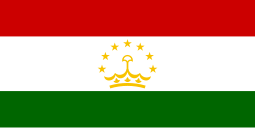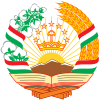Flag of Tajikistan
 | |
| Tajik: Парчами Тоҷикистон/Parčami Tojikiston/پَرچَمِ تاجِیکِستان | |
| Use | National flag |
|---|---|
| Proportion | 1:2 |
| Adopted | 24 November 1992[1] |
| Design | A horizontal tricolour of red, white and green in a 2:3:2 ratio, with a yellow crown surmounted by an arc of seven stars at the centre. |
| Designed by | Zuhur Habibullaev |
 | |
| Use | Presidential standard |
| Proportion | 1:2 |
| Design | A variant of the national flag charged with a gold Derafsh Kāviān extending beyond the central stripe with one seven-pointed star per corner and a winged lion at its center. |
 | |
| Use | Civil flag and ensign |
| Proportion | 1:2 |
| Design | A horizontal tricolour of red, white and green in a 2:3:2 ratio to distinguish it from the flag of Hungary. |
The national flag of Tajikistan (Tajik: Парчами Тоҷикистон / Parčami Tojikiston / پَرچَمِ تاجِیکِستان) was adopted in November 1992, replacing the flag of the Tajik Soviet Socialist Republic of 1953. The flag features Pan-Iranian colors in a horizontal tricolor of red, white (double width) and green, with a yellow crown surmounted by an arc of seven stars at the centre. It has a width ratio of 2:3:2.[2] The tricolor preserves the choice of colors in the former Tajik Soviet flag, as well as the 1:2 proportions.
The flag day is celebrated on 24 November,[3][4] which is the day it was officially adopted.[1]
Design and symbolism[edit]
The flag of Tajikistan is a tricolour of red, white, and green. The red represents the unity of the nation as well as victory and sunrise. The red also serves as symbolism of the former Russian and Soviet eras,[5] the workers,[6] and the warriors who sacrificed their lives to protect the land.[6] The white represents purity, morality, the snow and ice of the mountains, and cotton.[2][7][8][9] The green represents the bountiful generosity of nature, fertile valleys, the religion of Islam, and the celebration of Novruz.[9] Other interpretations of the colours state that the flag symbolically unifies the people of Tajik society, with the red stripe representing the manual labour class, the white stripe representing the intellectual worker class, and the green representing the agricultural class living in Tajikistan's rural or mountainous regions.[10]
While the red and green stripes on the top and bottom are equal in size, the center stripe is one-and-a-half times that of the others.
The crown and stars are set in a rectangle taking up 80% of the white stripe's height. The crown represents the Samanid dynasty and Tajik people, as the name Tajik is connected with Persian tâj "crown" in popular etymology.[11] The flag of Tajikistan features seven stars due to the significance of the number seven in Persian mythology, representing perfection and happiness. According to traditional belief, the heavens feature seven mountains and seven orchard gardens with a star shining above each mountain.[9]
(1992–present) |
White | Red | Yellow | Green |
|---|---|---|---|---|
| Pantone | Safe | 3546c | 7406c | 2273c |
| CMYK | 0-0-0-0 | 0-100-100-20 | 0-21-100-3 | 100-0-100-60 |
| RGB | 255-255-255 | 205-0-0 | 248-196-0 | 0-102-0 |
| Hexadecimal | #FFFFFF | #CD0000 | #F8C400 | #006600 |
Presidential standard[edit]
The standard of the president of Tajikistan was introduced in 2006, on the occasion of the inauguration ceremony for the third term of Emomali Rahmon as head of state. It uses the Tajik tricolour charged with a depiction of the Derafsh Kāviān, the Sassanid royal standard. Inside the Derafsh Kāviān is a depiction of a winged lion against a blue sky under a smaller representation of the crown and seven stars.[12]
The center of the standard features elements formerly used as symbols of Tajikistan in the Emblem of Tajikistan. The presidential standard also includes a star in each of the four corners to represent the four regions of Tajikistan.
Historical flags[edit]
Under Soviet rule, the Union Republic used a flag derived from the flag of the Soviet Union and representing Communism, that was approved in 1953.[13] The flag is similar to the Soviet Union design but with the addition of a white and a green stripe. This flag also contains the red-white-green color order where the white stripe is larger than the green, which is currently used in the national flag.
As a Soviet republic, the red symbolized the workers' revolution, the white symbolized cotton, and the green symbolized agriculture.[14][15]
The Soviet era flag was two-sided. Its backside was a mirror of the obverse face without the hammer, sickle, and star. Following independence on September 9, 1991, Tajikistan adopted its first post-independence flag by removing the Soviet symbolism from the canton, making the national flag identical to the backside of the Soviet era flag. This design remained in use until the new Tajik flag was adopted, making Tajikistan the last former Soviet country to receive a new flag.
Gallery[edit]
See also[edit]
- Emblem of Tajikistan
- National symbols of Tajikistan
- History of Tajikistan
- Flag of Iran (reverse order)
- Flag of Hungary (similar order)
References[edit]
- ^ a b Alfred Znamierowski: Flagi świata: ilustrowany przewodnik. Warszawa: Horyzont, 2002, s. 45. ISBN 83-7311-410-6
- ^ a b Embassy of Tajikistan to Belgium State Symbols Archived 2016-05-01 at the Wayback Machine "The crown and a star are entered in a rectangle, the sides of which on a vertical make 0,8 and across 1,0 width of a white stripe. Five-pointed stars are entered in a circle with diameter 0,15 and settle down on an arch radius of 0,5 width of a white stripe. There are three colors on a flag of the Republic of Tajikistan: green, red and white. A green stripe are valleys, they are not enough in republic - 7 % of territory. Because the rest of the territory is occupied by mountains. The white stripe is a color of the main richness of republic - cotton and also the color of snow and ice in high mountains. The red color is a color of unification of republic and brotherhood with other nations of the world."
- ^ "Tajikistan Celebrates First Flag Day Since Independence". RadioFreeEurope/RadioLiberty. Retrieved 2018-10-09.
- ^ AnydayGuide. "Flag Day in Tajikistan / November 24, 2018". AnydayGuide. Retrieved 2018-10-09.
- ^ "Tajikistan Flag and Description". www.worldatlas.com. Retrieved 2018-07-09.
- ^ a b "Flag Tajikistan: photos, history, meaning of colors of the national flag of Tajikistan". Articles about tourism: interesting tourist articles, articles about countries, resorts, tour tips and other useful information. Archived from the original on 2018-07-09. Retrieved 2018-07-09.
- ^ cotton, traditionally the main export commodity of the economy of Tajikistan, accounted for 13% of Tajikistan's exports in 2012 (now the second most important export category, behind aluminum at 55%).
- ^ "Tajikistan Flag - colors meaning history of Tajikistan Flag". tajikistanflag.facts.co. Archived from the original on 2017-10-25. Retrieved 2017-10-25.
- ^ a b c "Information about national flag of Tajikistan". www.advantour.com. Retrieved 2017-10-25.
- ^ "National Flag of Tajikistan |Tajikistan Flag Meaning,Picture and History". NationalPedia. 2017-04-25. Retrieved 2018-07-09.
- ^ The actual etymology of the name is unknown; it derives from a medieval exonym applied to a people of the Transoxania region, used to refer to either "Arabs" or "Persians"; according to the Library of Congress's 1997 Country Study of Tajikistan, it is difficult to definitively state the origins of the word 'Tajik' because the term is "embroiled in twentieth-century political disputes about whether Turkic or Iranian peoples were the original inhabitants of Central Asia." Library of Congress Call Number DK851 .K34 1997. The supposed connection of Tajik with tajvar "crowned" can be traced to 1990 (Echo of Islam, Issues 183-193, Ministry of Islamic Guidance, 2000, p. 54). The flag design being based on this etymology was reported in Alfred Znamierowski, The world encyclopedia of flags, Hermes House, 2002, p. 169.
- ^ Based on a Russian-language description of the flag posted at president.tj in 2006 (archived version from 2007).
- ^ Smith, Whitney. "Tajikistan, flag of". Encyclopedia Britannica. Encyclopedia Britannica, Inc. Retrieved January 23, 2017. (subscription required)
- ^ "Флаги Таджикистана -VEXILLOGRAPHIA". www.vexillographia.ru. Retrieved 2018-10-16.
- ^ "Tajikistan in the Soviet Union". www.crwflags.com. Retrieved 2018-10-16.
- ^ "Tajiks splash out $210 million on independence pomp". 9 September 2011. Retrieved 14 December 2011.
- ^ "Dushanbe's flagpole enters Guinness Book of Records". 1 September 2011. Retrieved 14 December 2011.
- ^ "Wer baut den hoechsten Fahnenmast". Asia Plus. 9 September 2008. Archived from the original on 4 April 2019. Retrieved 14 December 2011.
- ^ "Tallest Unsupported Flagpole". Guinness World Records. Retrieved 8 March 2018.






